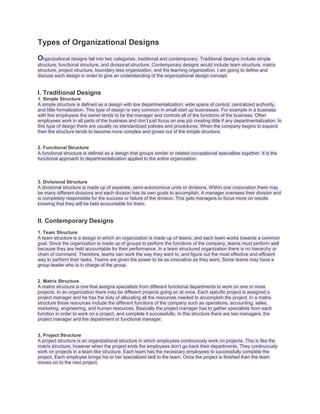
Types of organizational designs
- 1. Types of Organizational Designs Organizational designs fall into two categories, traditional and contemporary. Traditional designs include simple structure, functional structure, and divisional structure. Contemporary designs would include team structure, matrix structure, project structure, boundary less organization, and the learning organization. I am going to define and discuss each design in order to give an understanding of the organizational design concept. I. Traditional Designs 1. Simple Structure A simple structure is defined as a design with low departmentalization, wide spans of control, centralized authority, and little formalization. This type of design is very common in small start up businesses. For example in a business with few employees the owner tends to be the manager and controls all of the functions of the business. Often employees work in all parts of the business and don’t just focus on one job creating little if any departmentalization. In this type of design there are usually no standardized policies and procedures. When the company begins to expand then the structure tends to become more complex and grows out of the simple structure. 2. Functional Structure A functional structure is defined as a design that groups similar or related occupational specialties together. It is the functional approach to departmentalization applied to the entire organization. 3. Divisional Structure A divisional structure is made up of separate, semi-autonomous units or divisions. Within one corporation there may be many different divisions and each division has its own goals to accomplish. A manager oversees their division and is completely responsible for the success or failure of the division. This gets managers to focus more on results knowing that they will be held accountable for them. II. Contemporary Designs 1. Team Structure A team structure is a design in which an organization is made up of teams, and each team works towards a common goal. Since the organization is made up of groups to perform the functions of the company, teams must perform well because they are held accountable for their performance. In a team structured organization there is no hierarchy or chain of command. Therefore, teams can work the way they want to, and figure out the most effective and efficient way to perform their tasks. Teams are given the power to be as innovative as they want. Some teams may have a group leader who is in charge of the group. 2. Matrix Structure A matrix structure is one that assigns specialists from different functional departments to work on one or more projects. In an organization there may be different projects going on at once. Each specific project is assigned a project manager and he has the duty of allocating all the resources needed to accomplish the project. In a matrix structure those resources include the different functions of the company such as operations, accounting, sales, marketing, engineering, and human resources. Basically the project manager has to gather specialists from each function in order to work on a project, and complete it successfully. In this structure there are two managers, the project manager and the department or functional manager. 3. Project Structure A project structure is an organizational structure in which employees continuously work on projects. This is like the matrix structure; however when the project ends the employees don’t go back their departments. They continuously work on projects in a team like structure. Each team has the necessary employees to successfully complete the project. Each employee brings his or her specialized skill to the team. Once the project is finished then the team moves on to the next project.
- 2. 4. Autonomous Internal Units Some large organizations have adopted this type of structure. That is, the organization is comprised of many independent decentralized business units, each with its own products, clients, competitors, and profit goals. There is no centralized control or resource allocation. 5. Boudaryless Organization A boundaryless organization is one in which its design is not defined by, or limited to, the horizontal, vertical, or external boundaries imposed by a predefined structure. In other words it is an unstructured design. This structure is much more flexible because there is no boundaries to deal with such as chain of command, departmentalization, and organizational hierarchy. Instead of having departments, companies have used the team approach. In order to eliminate boundaries managers may use virtual, modular, or network organizational structures. In a virtual organization work is outsourced when necessary. There are a small number of permanent employees, however specialists are hired when a situation arises. Examples of this would be subcontractors or freelancers. A modular organization is one in which manufacturing is the business. This type of organization has work done outside of the company from different suppliers. Each supplier produces a specific piece of the final product. When all the pieces are done, the organization then assembles the final product. A network organization is one in which companies outsource their major business functions in order to focus more on what they are in business to do. 6. Learning Organization A learning organization is defined as an organization that has developed the capacity to continuously learn, adapt, and change. In order to have a learning organization a company must have very knowledgeable employees who are able to share their knowledge with others and be able to apply it in a work environment. The learning organization must also have a strong organizational culture where all employees have a common goal and are willing to work together through sharing knowledge and information. A learning organization must have a team design and great leadership. Learning organizations that are innovative and knowledgeable create leverage over competitors.
